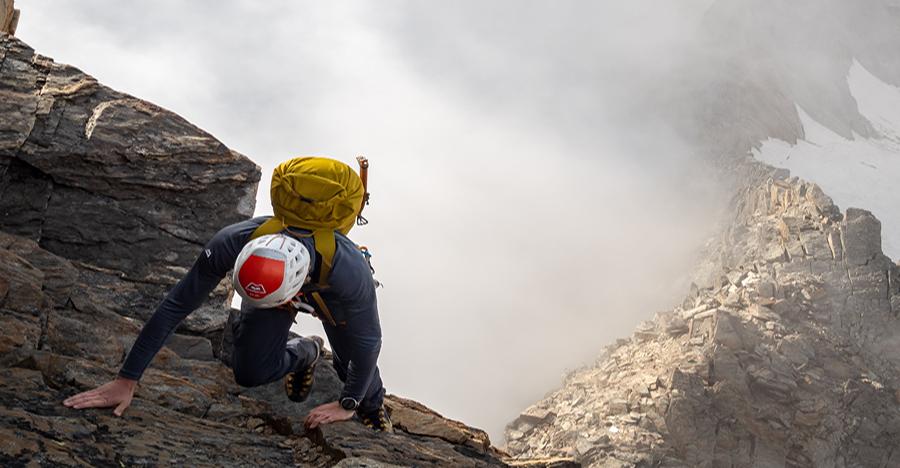Tom Livingstone’s Young Alpinist Meet Report

This Summer saw the first Young Alpinists Meet in the Valais region of Switzerland, it ran over 2 weeks and aimed to motivate young British alpinists so they may progress safely and efficiently in their alpine climbing. Over 25 people attended, all around 25 years old, and they quickly developed strong partnerships, sharing knowledge and ideas. Tom Livingstone, initially joined by Will Sim, was on hand to provide advice and structure to the meet.
At the initial briefing I was keen to stress that the meet was not a competition, nor a fast-track course in alpinism. Those taking part were to take responsibility for their own actions, and the program for the first week was simply to meet new partners and choose conservative routes with an emphasis on covering lots of ground and moving well.
Equipment for those receiving a bursary from the BMC was generously provided by Mountain Equipment and Petzl (all 18 people who applied for a bursary were given a fair share of the funds). Each applicant received a 37L Tupilak Pack, a Tupilak Atmo Jacket, a Groundup Tee and a Petzl Actik+ headtorch. A Sirocco helmet and Volta Guide 60m 9mm rope were also raffled during the Meet.
Each evening, everyone gathered at the campsite to discuss their thoughts on the day, the things they’d learnt, and their plans for the following days. ‘Circle time’ became a valuable part of the Meet and an important part of the process.

During the first few days, climbers practiced their skills on classic routes like the south ridge of the Lagginhorn, the north ridge of the Weissmeis, the Lenspitze – Nadelhorn traverse and the Holabgrat on the Alallinhorn.
In practical terms, we debated when and how to use the rope, when to pitch and when to move together, what natural features we could use with the rope, how long to keep a practical and safe distance between climbers, and ways to make moving together safer. We also discussed speed and why it can – but not always – equal safety, how best to approach and descend from routes, and gear.
In mental terms, we considered our attitudes to risk, reward and revelry. We also debated other climbers in the mountains, and their effects on us. We talked about ‘the big picture,’ such as when and how to plan an alpine trip, when to take rest days, when to be productive with our time, when to be ambitious, and when to know you’re relying on your partner.
Route choices were also discussed and I often encouraged people to not simply follow other’s suggestions or ideas, looking beyond the obvious. Routes which were local classics were not necessarily the best choices and we were keen to avoid bolted multi-pitch climbs with clear online topos. This form of ‘alpinism’ was not the emphasis of the Meet. Instead, participants needed to think for themselves, come up with original ideas, and fully research their objectives. I’d seen much of this first-hand during the Slovenian-Scottish exchange in 2018/2019, mentored in part by Ian Parnell and Marko Prezelj, and wanted to replicate this mindset.
Part of the lesson was to ignore grades, reports and egos, and instead enjoy being in the mountains, acting and reacting with whatever we found. Participants were pushed outside of their comfort zones, but with the idea being to progress in a way they ultimately benefited from.

By the end of the two weeks, there was a clear team spirit amongst the group, with people exchanging ideas and feedback. We discussed the variability of the weather, and even benefited from some rainy days in order to practice skills like hauling a pack on an alpine route, building belays carefully and efficiently, and managing the ropes.
During the rest of the Meet, participants enjoyed bigger adventures, such as the west pillar of the Scheidiggwetterhorn, the Schreckhorn, routes on the Kingspitze, the south ridge of the Rothorngrat on Zinalrothorn, the Ober Gabelhorn, the Alallinhorn-Alphubel-Tasch-Dom traverse, and the Bishorn. On the final night of the Meet, participants debriefed while enjoying a meal at a local Swiss restaurant. Everyone left with new partners, fresh motivation and plenty of route ideas.
Overall it felt like a really successful first event, plans for the future are still developing but they’re likely to focus on those who have accumulated a large amount of alpine climbing experience, and wish to progress to harder routes. Watch this space for more on potential summer and winter meets, it’s something we’re keen to continue!
 USA
USA United Kingdom
United Kingdom Germany
Germany